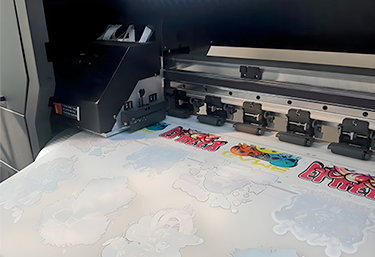

The last few years have seen huge growth in the Direct-to-Film market, which can be easily seen at any recent Fespa trade show with DtF solutions popping up on many of the stands throughout all the halls. The appeal is obvious. The machines are generally quite inexpensive, reasonably compact and easy to operate. The final prints can be applied to many different textile substrates, including polyester garments, without any of the hassle associated with dye sublimation.
The basic concept behind printing Direct-to-Film is fairly well established by now. The film is supplied on a roll and fed first through the printer, where the inks are laid down but left wet and tacky, then onto the powder shaker, where the powder is applied and shaken to ensure an even distribution that only sticks to the image areas where the ink is. The film web then passes under the heater where the powder is melted, effectively turning it into a hot melt glue layer.
It’s not a particularly sophisticated process, which explains why the market has been completely dominated by relatively cheap and cheerful Chinese devices. This has caught most of the more established printer vendors on the hop, and they have struggled to add value whilst still remaining competitive. Not surprisingly, most vendors have opted to simply rebadge Asian solutions, mostly from Chinese manufacturers, but there was some evidence at the recent Fespa Global Exhibition that the established printer vendors are looking at ways to further develop this technology.
 Epson’s SureColor G6000 is a dedicated DtF printer. ©Nessan Cleary
Epson’s SureColor G6000 is a dedicated DtF printer. ©Nessan Cleary
Epson, for example, showed its first dedicated DTF printer, the SC-G6000. It’s a roll-to-roll printer, taking media up to 900mm with a print width of 894mm, which is wider than the more usual 60cm but not radically so. It prints Epson’s UltraChrome DtF inkset, which includes CMYK and white, with the inks supplied in 1.6l cartridges. Naturally it uses Epson’s PrecisionCore printheads, and includes recirculation for the white ink. Epson claims to have upgraded the maintenance system for the printheads, by using fabric rather than rubber to wipe excess ink away the heads. The rubber wiper itself had to be periodically cleaned so this should lead to less manual maintenance though the fabric spool will be another consumable item. It produces around 5.6sqm/hr when printing both the colours and white ink.
The recent Fespa show in Berlin, Germany, revealed a sudden growth in a variant of DtF that uses UV ink instead of the normal aqueous ink. The process involves two separate rolls of clear film, one fed from the backside and one from the front. The rear film has an adhesive layer on top, with the ink printed on top of this. After printing, the second film, which is essentially a laminate layer is pressed on to it, using nothing but pressure. This allows the graphic to be handled and, for example, to be posted to a customer.
To apply the graphic, you just have to peel the top layer off, press the graphic against the object you want to decorate and then rub it to force the ink in the graphic to transfer. There’s no need for heat or any kind of press as hand pressure on its own is enough.

Unlike the other UV DtF solutions, this is primarily aimed at textiles. It’s not really suitable for clothing because it doesn’t offer much in the way of washfastness. It was mostly demonstrated on tote bags but it seems to me that it would be much more effective on hats.
Taken together, these various solutions demonstrate that the DtF market is showing no signs of slowing down, and is actively expanding into new applications.